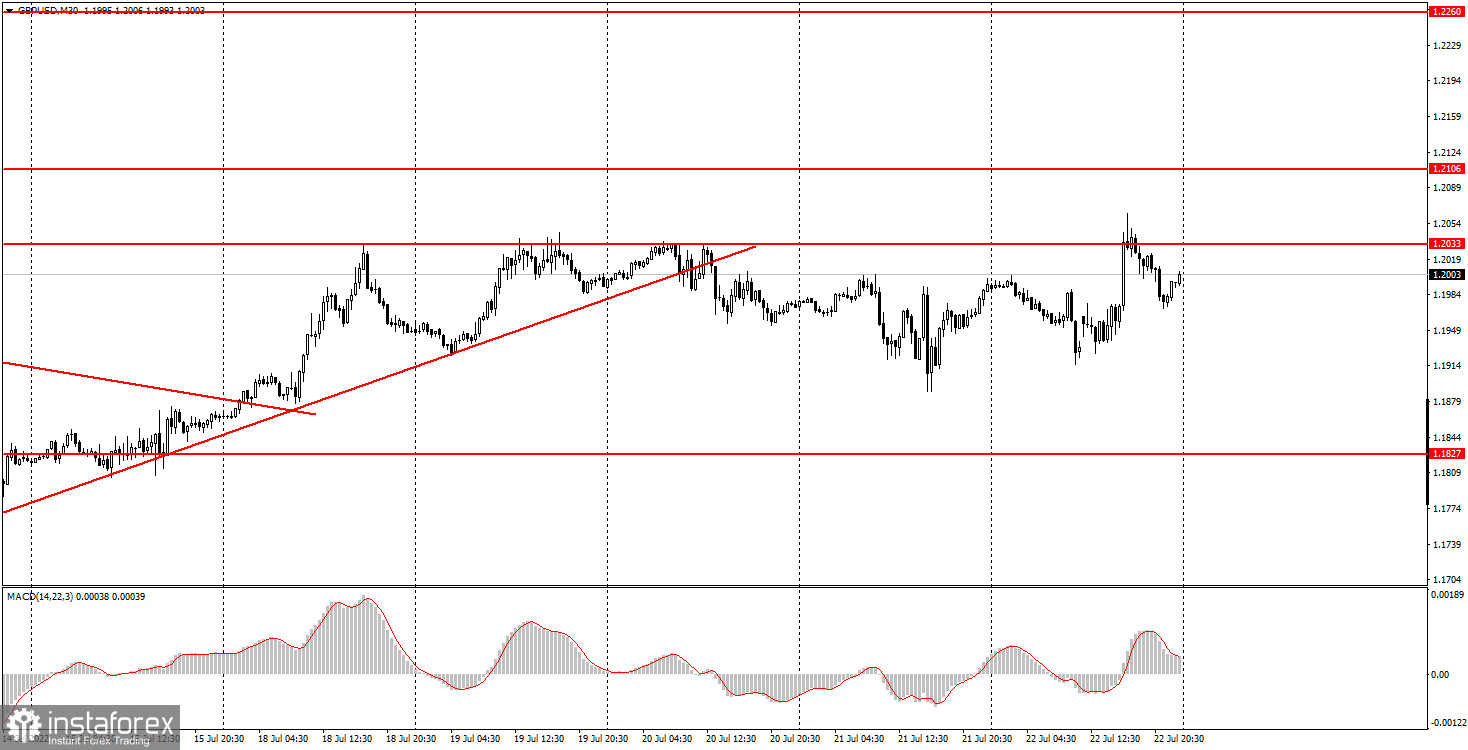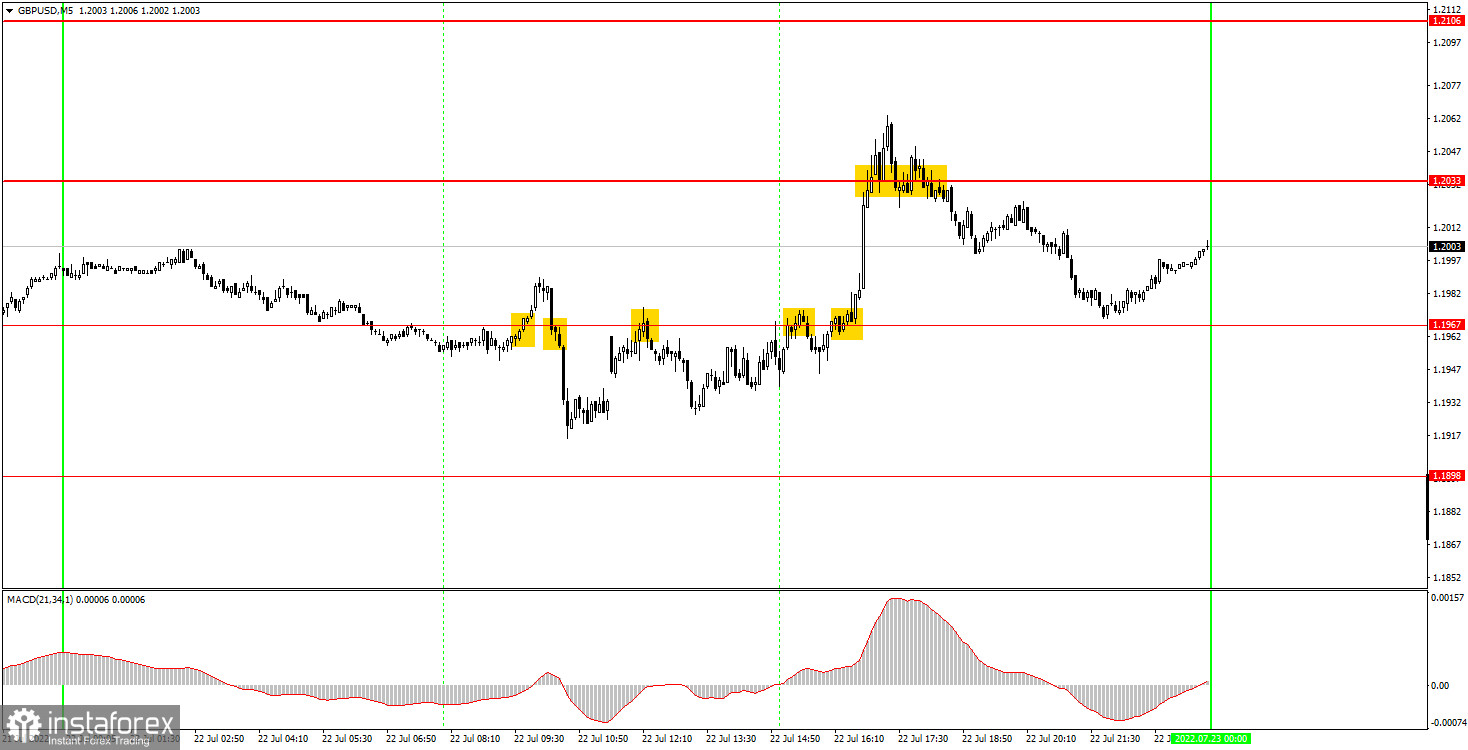Analysis of Friday's deals:
30M chart of the GBP/USD pair

The GBP/USD pair was also trading quite volatile, which was triggered by almost the same factors as the movements in the EUR/USD pair. Indexes of business activity and retail sales were published in the UK in the morning, and indexes of business activity in the US were published in the afternoon. Despite the fact that the statistics from the UK were not of a disastrous nature, the data were still weaker than forecasts, so the pound was slowly sliding down. But traders received weak data from overseas in the afternoon, so they began to sell the dollar. This did not lead to significant changes in technical terms. The pair ended the day near 1.2033 and its fourth test was just as bad as the previous three. As a result, the pound again failed to resume the upward movement and remains very close to its 2-year lows, keeping the chances of both growth and fall. Therefore, the next two weeks will be very important for it. First, the Federal Reserve will hold a meeting, at which the rate will be almost guaranteed to be raised by 0.75%, and then there will be a Bank of England meeting, at which the rate will also be raised, almost guaranteed.
5M chart of the GBP/USD pair

The movement and signals on the 5-minute timeframe on Friday were rather ambiguous. Five out of six signals were formed around the 1.1967 level. It was evident that the British and US statistics came as a surprise to the market, as at first the pound was growing, but it began to fall sharply after the UK data was released. The same is true in the US trading session. Thus, the first buy signal turned out to be false, and novice traders received a loss on it. The second sell signal also turned out to be false, as the pair failed to reach the target level of 1.1898. The deal was closed by Stop Loss set to breakeven. Accordingly, the third, fourth and fifth signals should not have been worked out. The sixth signal initially suggested further growth of the pair, but it had already formed quite late. And just half an hour later, the pair settled below the level of 1.2033 and started a good downward movement, but this signal was formed too late to work it out. As a result, it was possible to open positions only on the first two signals.
How to trade on Monday:
The GBP/USD pair continues to move in a very similar way to the EUR/USD pair on the 30-minute time frame. The pound failed to overcome the level of 1.2033 from four attempts, so further growth remains a big question. Also, the price has overcome the ascending trend line, so the chances of a fall increase. Well, plus, the Federal Reserve will hold a meeting next week, which will definitely be a new aggressive tightening of monetary policy, to which the market, in theory, should respond by buying the US currency. On the 5-minute TF on Monday, it is recommended to trade at the levels 1.1807-1.1827, 1.1898, 1.1967, 1.2033, 1.2106, 1.2170. When the price passes after opening a deal in the right direction for 20 points, Stop Loss should be set to breakeven. There are no major events or reports scheduled for Monday in the UK and US. But, as in the case of the euro, there may be strong movements and the growth of the US dollar.
Basic rules of the trading system:
1) The signal strength is calculated by the time it took to form the signal (bounce or overcome the level). The less time it took, the stronger the signal.
2) If two or more deals were opened near a certain level based on false signals (which did not trigger Take Profit or the nearest target level), then all subsequent signals from this level should be ignored.
3) In a flat, any pair can form a lot of false signals or not form them at all. But in any case, at the first signs of a flat, it is better to stop trading.
4) Trade deals are opened in the time period between the beginning of the European session and until the middle of the American one, when all deals must be closed manually.
5) On the 30-minute TF, using signals from the MACD indicator, you can trade only if there is good volatility and a trend, which is confirmed by a trend line or a trend channel.
6) If two levels are located too close to each other (from 5 to 15 points), then they should be considered as an area of support or resistance.
On the chart:
Support and Resistance Levels are the Levels that serve as targets when buying or selling the pair. You can place Take Profit near these levels.
Red lines are the channels or trend lines that display the current trend and show in which direction it is better to trade now.
The MACD indicator (14,22,3) consists of a histogram and a signal line. When they cross, this is a signal to enter the market. It is recommended to use this indicator in combination with trend lines (channels and trend lines).
Important speeches and reports (always contained in the news calendar) can greatly influence the movement of a currency pair. Therefore, during their exit, it is recommended to trade as carefully as possible or exit the market in order to avoid a sharp price reversal against the previous movement.
Beginners on Forex should remember that not every single trade has to be profitable. The development of a clear strategy and money management are the key to success in trading over a long period of time.
 English
English 
 Русский
Русский Bahasa Indonesia
Bahasa Indonesia Bahasa Malay
Bahasa Malay ไทย
ไทย Español
Español Deutsch
Deutsch Български
Български Français
Français Tiếng Việt
Tiếng Việt 中文
中文 বাংলা
বাংলা हिन्दी
हिन्दी Čeština
Čeština Українська
Українська Română
Română

